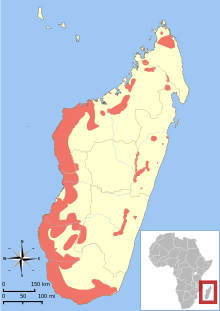Mouse lemur
| Mouse lemurs | |
|---|---|

| |
| Pygmy mouse lemur (M. myoxinus) | |
| Scientific classification | |
| Domain: | Eukaryota |
| Kingdom: | Animalia |
| Phylum: | Chordata |
| Class: | Mammalia |
| Order: | Primates |
| Suborder: | Strepsirrhini |
| Family: | Cheirogaleidae |
| Genus: | Microcebus É. Geoffroy, 1834[1] |
| Type species | |
| Lemur pusillus É. Geoffroy, 1795
| |
| Diversity | |
| About 25 species | |

| |
| Combined distribution of Microcebus[3] | |
| Synonyms[1][4] | |
| |
The mouse lemurs are
Mouse lemurs have a combined head, body and tail length of 20–30 centimetres (7.9–11.8 in) and weigh 30–65 grams (1.1–2.3 oz),[5] making them the smallest primates[6] (the smallest species being Madame Berthe's mouse lemur); however, their weight fluctuates in response to daylight duration.[7] Lemurs and mouse lemurs were announced by the IUCN as the most endangered of all vertebrates. There were two known mouse lemur species in 1992; by 2016, there were 24.[8] It was estimated that the 24 mouse lemur species evolved from a common ancestor 18–11 million years ago.[9]
Mouse lemurs are
Mouse lemurs are considered cryptic species—with very little morphological differences between the various species, but with high genetic diversity. Recent evidence points to differences in their mating calls, which is very diverse. Since mouse lemurs are nocturnal, they might not have evolved to look differently, but had evolved various auditory and vocal systems.[citation needed]
Mouse lemur brains can weigh less than 2 grams (0.071 oz) while their testes can weigh 2.5 grams (0.088 oz).[11]
As written in Genetics, mouse lemurs help to provide a more extensive understanding of the biology, behavior, and health of primates. Mouse lemurs are categorized as prosimian primates. They are among the smallest and most rapidly developing primates and are becoming more abundant in Madagascar and around the world. These tiny creatures are helping to prove valuable information about the biology and evolution of primates through the analysis of their phenotypes and mutations, especially as a model organism for human medical research.[12]
Reproduction and evolution
Mouse lemurs are also known for their sperm competition. During breeding seasons, the testicles of male mouse lemurs increase in size to about 130% of their normal size. This was speculated to increase the sperm production thereby conferring an advantage for the individual to bear more offspring. There are various hypotheses relating the rapid evolution of mouse lemur species to this sperm competition.[13] In sexually inactive females the vulva is sealed, during the reproductive cycle the vulva is open. The vaginal morphology is also based on the time of day.[14] Analysis of the genomes of five different mouse lemur species revealed that Madagascar’s biogeography had been undergoing change before the arrival of humans.[15]
Species
- Genus Microcebus: mouse lemurs[16]
- Arnhold's mouse lemur, M. arnholdi[17]
- Madame Berthe's mouse lemur, M. berthae
- Bongolava mouse lemur M. bongolavensis[18]
- Boraha mouse lemur M. boraha[19]
- Danfoss' mouse lemur M. danfossi[18]
- Ganzhorn's mouse lemur. M. ganzhorni[19]
- Gerp's mouse lemur. M. gerpi[20]
- Reddish-gray mouse lemur, M. griseorufus
- Jolly's mouse lemur, M. jollyae
- Jonah's mouse lemur, M. jonahi
- Goodman's mouse lemur, M. lehilahytsara
- MacArthur's mouse lemur, M. macarthurii[21]
- Claire's mouse lemur, M. mamiratra, synonymous to M. lokobensis[18]
- Bemanasy mouse lemur, M. manitatra[19]
- Margot Marsh's mouse lemur, M. margotmarshae[17]
- Marohita mouse lemur, M. marohita[22][23]
- Mittermeier's mouse lemur, M. mittermeieri
- Gray mouse lemur, M. murinus
- Pygmy mouse lemur, M. myoxinus
- Golden-brown mouse lemur, M. ravelobensis
- Brown mouse lemur, M. rufus
- Sambirano mouse lemur, M. sambiranensis
- Simmons' mouse lemur, M. simmonsi
- Anosy mouse lemur. M. tanosi[22][23]
- Northern rufous mouse lemur, M. tavaratra[24]
References
- ^ ISBN 978-0-231-11013-6.
- ^ "Checklist of CITES Species". CITES. UNEP-WCMC. Retrieved 18 March 2015.
- ^ "IUCN 2014". IUCN Red List of Threatened Species. Version 2014.3. International Union for Conservation of Nature. 2012. Retrieved 12 March 2015.
- ^ OCLC 62265494.
- ISBN 978-84-96553-89-7.
- ^ "Primate Factsheets: Mouse lemur (Microcebus) Taxonomy, Morphology, & Ecology". wisc.edu.
- .
- ^ "Yoder Lab – Research". duke.edu.
- PMID 18245770.
- ISBN 978-84-96553-89-7.
- PMID 20961963.
- PMID 28592502.
- ^ Folia Primatol (Basel). 2003 Sep–Dec;74(5–6):355-66. Mating system in mouse lemurs: theories and facts, using analysis of paternity. Andrès M1, Solignac M, Perret M.
- S2CID 21709451.
- ^ Golembiewski, Kate (18 July 2016). "Ridiculously Cute Mouse Lemurs Hold Key to Madagascar's Past". Field Museum of Natural History. Retrieved 13 January 2022.
- S2CID 17614597.
- ^ S2CID 84533039. Archived from the original(PDF) on 2009-02-05.
- ^ S2CID 84701328. Retrieved 2007-12-10.
- ^ S2CID 43912903.
- S2CID 8473176.
- ^ "New Primate Species Discovered on Madagascar". Archived from the original on 2011-07-19. Retrieved 2008-07-15.
- ^ S2CID 17860060.
- ^ LiveScience.
- PMID 32716088.
External links
 Media related to Microcebus at Wikimedia Commons
Media related to Microcebus at Wikimedia Commons- Mouse lemur skeleton – Skeleton from the University of Texas at Austin
- BBC video clips and news articles
